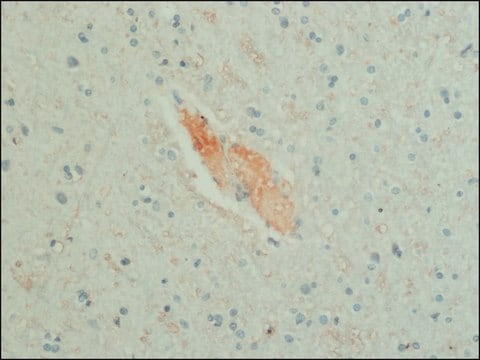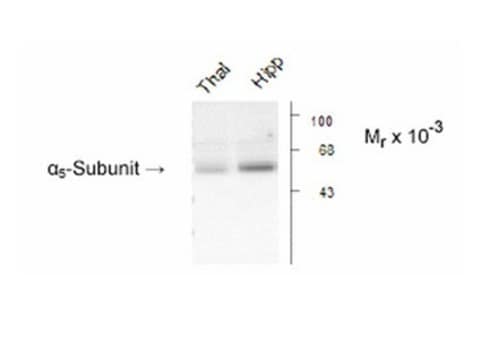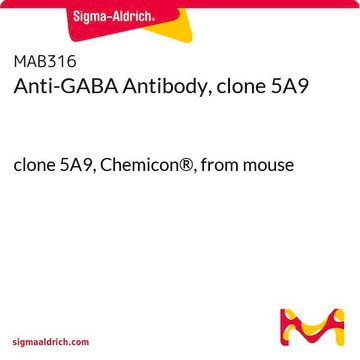AB175
Anti-GABA Antibody
serum, Chemicon®
Synonim(y):
Anti-GABA Receptor Antibody, GABA Receptor Antibody
About This Item
Polecane produkty
pochodzenie biologiczne
guinea pig
Poziom jakości
forma przeciwciała
serum
rodzaj przeciwciała
primary antibodies
klon
polyclonal
reaktywność gatunkowa
rat
reaktywność gatunkowa (przewidywana na podstawie homologii)
all
producent / nazwa handlowa
Chemicon®
metody
ELISA: suitable
immunohistochemistry: suitable (paraffin)
Warunki transportu
dry ice
docelowa modyfikacja potranslacyjna
unmodified
informacje o genach
rat ... Gabra1(29705)
Opis ogólny
Specyficzność
Immunogen
Zastosowanie
ELISA Analysis: A representative lot from an independent laboratory detected GABA in a competitive ELISA.
Immunohistochemistry Protocol:
Tissues fixed with 4% paraformaldehyde and 0-0.5% glutaraldehyde gives good results. Glutaraldehyde is required for antibody reactivity.
1) Tissue is fixed with 4% paraformaldehyde, 0-0.5% glutaraldehyde, 0.5% potassium dichromate in 0.1M phosphate buffer at pH 6.5.
2) Tissue is post-fixed overnight, vibratome sectioned in 50 mm and incubated in 0.05M Tris buffer, pH 6.5 for three hours.
3) Sections are incubated for 18-24 hours in AB175 diluted in PBS containing 0.1% sodium azide, 0.2% Triton X-100 and 1% normal goat serum.
4) Fluorescein conjugated antibody or ABC system may be used as the secondary reagent.
Note: Without colchicine pretreatment well-stained cell bodies are visible in the cerebral cortex, cerebrallar cortex, superior colliculus and some brainstem raphe. With colchicine pretreatment, additional cell body staining is present in the interpeduncular nucleus and the dorsal column nuclei.
Neuroscience
Neurotransmitters & Receptors
Jakość
Immunohistochemistry Analysis: A 1:500 dilution of this antibody detected GABA in rat brain tissue.
Postać fizyczna
Przechowywanie i stabilność
Handling Recommendations: Upon receipt and prior to removing the cap, centrifuge the vial and gently mix the solution. Aliquot into microcentrifuge tubes and store at -20°C. Avoid repeated freeze/thaw cycles, which may damage IgG and affect product performance.
Komentarz do analizy
Rat Brain tissue
Inne uwagi
Informacje prawne
Oświadczenie o zrzeczeniu się odpowiedzialności
Not finding the right product?
Try our Narzędzie selektora produktów.
Kod klasy składowania
12 - Non Combustible Liquids
Klasa zagrożenia wodnego (WGK)
WGK 1
Temperatura zapłonu (°F)
Not applicable
Temperatura zapłonu (°C)
Not applicable
Certyfikaty analizy (CoA)
Poszukaj Certyfikaty analizy (CoA), wpisując numer partii/serii produktów. Numery serii i partii można znaleźć na etykiecie produktu po słowach „seria” lub „partia”.
Masz już ten produkt?
Dokumenty związane z niedawno zakupionymi produktami zostały zamieszczone w Bibliotece dokumentów.
Nasz zespół naukowców ma doświadczenie we wszystkich obszarach badań, w tym w naukach przyrodniczych, materiałoznawstwie, syntezie chemicznej, chromatografii, analityce i wielu innych dziedzinach.
Skontaktuj się z zespołem ds. pomocy technicznej








